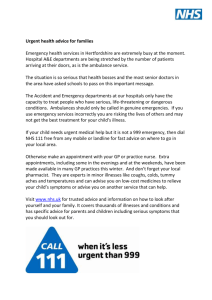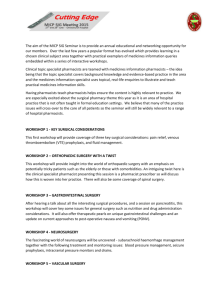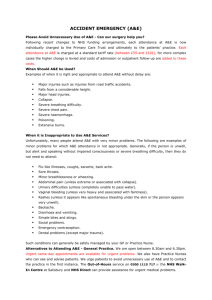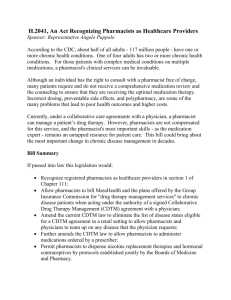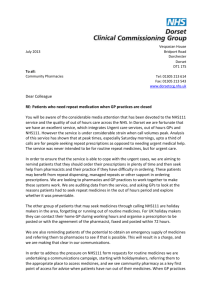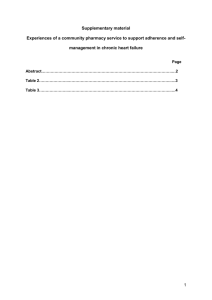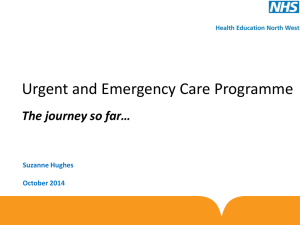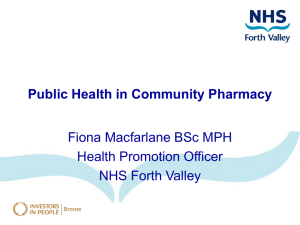Commissioners
advertisement
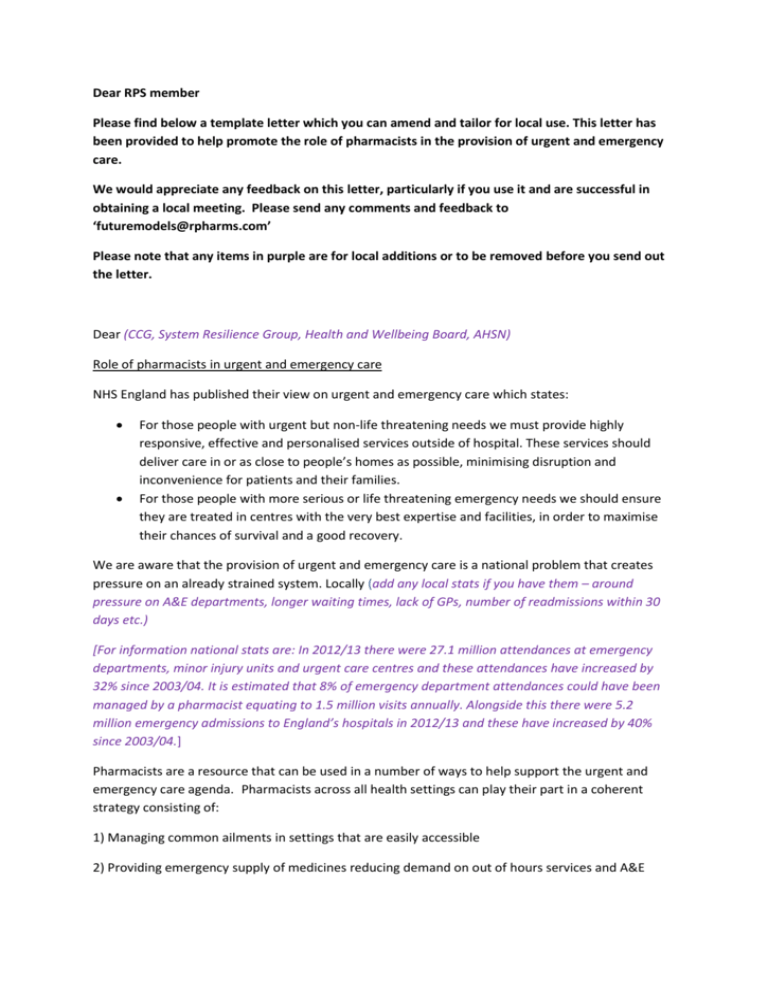
Dear RPS member Please find below a template letter which you can amend and tailor for local use. This letter has been provided to help promote the role of pharmacists in the provision of urgent and emergency care. We would appreciate any feedback on this letter, particularly if you use it and are successful in obtaining a local meeting. Please send any comments and feedback to ‘futuremodels@rpharms.com’ Please note that any items in purple are for local additions or to be removed before you send out the letter. Dear (CCG, System Resilience Group, Health and Wellbeing Board, AHSN) Role of pharmacists in urgent and emergency care NHS England has published their view on urgent and emergency care which states: For those people with urgent but non-life threatening needs we must provide highly responsive, effective and personalised services outside of hospital. These services should deliver care in or as close to people’s homes as possible, minimising disruption and inconvenience for patients and their families. For those people with more serious or life threatening emergency needs we should ensure they are treated in centres with the very best expertise and facilities, in order to maximise their chances of survival and a good recovery. We are aware that the provision of urgent and emergency care is a national problem that creates pressure on an already strained system. Locally (add any local stats if you have them – around pressure on A&E departments, longer waiting times, lack of GPs, number of readmissions within 30 days etc.) [For information national stats are: In 2012/13 there were 27.1 million attendances at emergency departments, minor injury units and urgent care centres and these attendances have increased by 32% since 2003/04. It is estimated that 8% of emergency department attendances could have been managed by a pharmacist equating to 1.5 million visits annually. Alongside this there were 5.2 million emergency admissions to England’s hospitals in 2012/13 and these have increased by 40% since 2003/04.] Pharmacists are a resource that can be used in a number of ways to help support the urgent and emergency care agenda. Pharmacists across all health settings can play their part in a coherent strategy consisting of: 1) Managing common ailments in settings that are easily accessible 2) Providing emergency supply of medicines reducing demand on out of hours services and A&E 3) Supporting services in Urgent Care Centres, Walk in centres and A&E both through triage and having pharmacist prescribers in these settings 4) Supporting NHS Pathways call handlers in NHS 111, assisting in general calls about medicines, toxic ingestions, referrals for emergency medicines supply and common ailments to community pharmacies and calls about complex medicine regimens such as residents in care homes 5) Supporting GP out of hour providers by dealing with medicines optimisation issues developing prescribing guidelines for GPs to use in their triage and face to face consultations and engagement with local CCGs and NHS 111 providers 6) Supporting prevention through vaccine administration, particularly flu and pneumococcal vaccinations 7) Provision of healthy living advice and support for long term conditions (LTCs) to prevent LTC urgent / acute admissions 8) Provision of medicines optimisations services such as medicine reviews on discharge, assessment of patients experiencing polypharmacy etc to prevent admissions and readmissions, thereby reducing pressure on secondary care services Primary care support In primary care, community pharmacists are well placed to provide a number of services to patients and the public which can prevent patients utilising more expensive NHS resources. These services are outlined in ‘Community Pharmacy- helping provide better quality and resilient urgent care’ and it’s supporting appendices. The three services outlined in this document are: - ‘Flu vaccine administration to ‘at risk’ populations Emergency supply of repeat medicines - Supporting deprived populations to self-care with NHS provided medicines via delivery of a common ailment service Recent evidence demonstrates that if community pharmacists were commissioned to provide a common ailment service nationwide, the NHS could save £1.1 billion each year. The cost of treating common ailments in community pharmacies was found by the study to be £29.30 per patient. The cost of treating the same problems at A&E was found to be nearly five times higher at £147.09 per patient and nearly three times higher at GP practices at £82.34 per patient. Treatment results for patients were equally good regardless of whether patients were treated at a pharmacy, A&E or GP practice Other services that are often provided by community pharmacists include flu vaccinations and emergency supply of medicines. The table below shows the total number of flu vaccinations given in community pharmacy setting and total jabs given per CCG area in London (taken from a sample of CCGS in London).1 Patients find services provided by pharmacists more convenient as they do not have to get appointments and can just walk in and get their flu vaccination2. Locally, the services that pharmacists provide to support the urgent and emergency care agenda need to be linked into the delivery of NHS 111 and integrated into the local Directory of Services, where appropriate. This will ensure that pharmacists play their role in supporting patients and ensuring that responsive and effective services are provided locally. Secondary care support Pharmacists working in secondary care also have a role to play. HEE West Midlands have pharmacist prescribers working in a number of their A&E departments. Early evidence shows that a significant number of patients coming into A&E can be dealt with by a pharmacist prescriber who has been trained in advanced U&E care. It has been demonstrated that pharmacist prescribers in urgent care settings such as walk in centres could see and deal with 43% of patients. In any setting it is beneficial to patients if pharmacists have access to the most recent patient information (electronic patient record) on the basis of ensuring system wide knowledge of what else has occurred in the patient journey. Any interventions made by the pharmacist should also be recorded in the patient record so that the next professional caring for the patient is aware of such interventions. For more information on how pharmacists can support the U&E care agenda please see http://www.rpharms.com/our-campaigns/improving-urgent-and-emergency-care-through-betteruse-of-pharmacists.asp 1Matharu and Shah, The London Flu Service 2013/14, The Voice of London Community Pharmacy Committees Claire Anderson and Tracey Thornley (2014) “It’s easier in pharmacy”: why some patients prefer to pay for flu jabs rather than use the National Health Service BMC Health Services Research 2014, 14:35 2 I am sure you agree that this is an important opportunity to explore and I /we would be happy to meet with you to see how pharmacists can contribute and play their full part in supporting the local urgent and emergency care agenda. Please contact me ......( add your name, job title, email, phone number)
